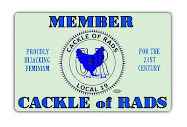Not when he attempts to fly that thing. Assuming that he neglects to get an airworthiness inspection before he tries to fly it.
I've never seen a wooden spar with lightening holes drilled in it. My guess is that if he were to get the thing up to any decent speed on a runway, the wings would fold up around him.
Which would be good, as that might keep him out of a grave.
But probably not. Odds are that he'll put the fuel tank just behind the engine, so it'll burn like a pyre in the post-crash fire regardless.
The Grumbling
3 minutes ago









7 comments:
Actually, based on my understanding of truss design, those lightening holes will not affect the strength of that spar in any significant way. The deal being that wood is very strong in compression, and the ovals serve as arches to move compressive forces to the pieces of wood inbetween the holes. The main strength limitation of a spar is extension strength, which is controlled by the top 1/2" and bottom 1/2" of the spar, which he has left untouched. That is the central observation that makes housing trusses possible, because housing trusses take what was once a 2x12 or 2x12 roof rafter and turn it into a web of 2x4's that shifts weight via connecting struts instead. A roof truss made entirely of 2x4's will span a far longer distance than a 2x12 -- 40' trusses are not unusual, longer trusses are possible but not usually done because of the difficulty transporting them to the site from the factory -- and roof trusses are primarily open air.
That said, I would hope he's doing some really serious structural engineering on this thing to make sure it'll take the forces involved in flight. Eyeballing it is not enough. We can eyeball roof truses because even an eyeballed roof truss is ridiculously overstrong for the forces it's subject to, but we know roof trusses well. Wing trusses... not so well.
And he's using a 4" electrical extension ring box as part of his gimbaling. Lordy, the guy is selling seats to his assault on the Darwin Prize
The biggest issue I see is consistency. Your average wood from homedespot without a lot of hand picking is variable at best. That means your parts have to have adequate overbuild to meet minima.
Usually for small planes its all to easy to over build.
Can it be done, yes, and with much care.
Actually in the case of wood spars holes are not an issue so lone as the top and bottom caps are really good (no knots and grain runs the length. Same for ribs.
My worry is termites and rot.
Eck!
I looked at spars for light airplanes. The wooden ones are solid. J-3s, Staggerwings, even T-50s. Though for the T-50s, they have to laminate several pieces of wood to get the thickness and scarf them together to get the length.
From what I can see, nobody built wooden airplanes with spars that have lightening holes.
Except the soon-to-be-late Home Depot Guy...
My worry is termites and rot.
Which is why you will find few wood-wing-spar'ed aircraft in the air anymore. Water gets in to the wing and rots them and you get mid-air failures. Bad Form. Several wood-spar'ed Mooneys have torn apart in mid air because of that in recent years.
Regarding holes in the wing spars, the wing spars of a Dehavilland Mossquito were constructed of 1x2 stringers connected together by plywood risers. The primary purpose of this was to give the wings their proportional sweep (thick at the wing root, thin at the wing tip) without requiring a lot of craftsmanship (a lot easier to cut plywood to form then glue it to 1x2's), but basically the middle of the spar was mostly air. Yet these planes were quite airworthy. That was because of the same principle that I mentioned above about how it was the bottom and top of the spar that carried the vast majority of the force, with the inner part carrying mostly compressive forces and needing far less wood to do so because wood is stronger in compression than in extension.
As for why you don't see wood-winged light aircraft with lightening holes in their wing spars, two things: a) most such aircraft were designed before modern understanding of the characteristics of wood spars, they were designed before the introduction of wooden trusses for home construction for cryin' out loud, and certainly before the invention of computer software for doing truss design (yes, there's software to do this), and b) it requires a lot of labor, and labor is money, and less labor is more profit since prices are set by the market rather than by cost of manufacturing (as many manufacturers have found to their chagrin when forced to sell below their cost and thus forced out of business). In other words, they had no way of knowing whether it'd be safe because the science didn't exist back then, and it would have cost money, so they didn't do it. But we understand a lot more about trusses today. Whether this potential Darwin Award candidate has read that research and done the math, however, is unknown.
It'll be just like going to a Nascar event just to wait for the crash.
Some really get off watching such.
Bring the Budweiser and Brats, yeehaw !
This dork has no clue what he is doing.
Nice shed. Save for the details like a supporting foundation. If he builds everything like that we know the outcome.
Safe air planes depend on attention to small details.
The holes in the spar are not an issue whats missing is the top cap and the bottom cap (I-beam structure) that makes it workable.
Same for the ribs. Without that stress structure its not near as strong as needed.
Most all old wood birds are of glue ans screw style of construction.
Aircraft ply is a far higher grade than even cabinet makers ply.what he is using is crap.
None of the bolts are properly backed and in very short time will start working (compressing, chafing the wood and loosening). In his bellcrank system there is excess play and room of elastic movement,
can you say flutter?
He can build it and it will be a great waste of time as the FAA will not permit it to fly (no builders log, plans or periodic inspection).
He'd be better to build the old Pietenpol AirCamper, at least that was a good flyer with 25hp.
Allison
Post a Comment